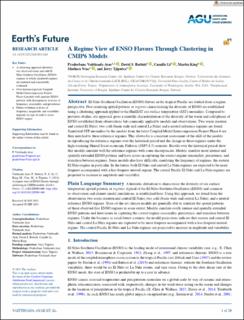| dc.contributor.author | Ayar, Pradeebane Vaittinada | |
| dc.contributor.author | Battisti, David Stephen | |
| dc.contributor.author | Li, Camille | |
| dc.contributor.author | King, Martin | |
| dc.contributor.author | Vrac, Mathieu | |
| dc.contributor.author | Tjiputra, Jerry | |
| dc.date.accessioned | 2023-11-14T09:08:25Z | |
| dc.date.available | 2023-11-14T09:08:25Z | |
| dc.date.created | 2023-11-02T12:42:44Z | |
| dc.date.issued | 2023 | |
| dc.identifier.issn | 2328-4277 | |
| dc.identifier.uri | https://hdl.handle.net/11250/3102339 | |
| dc.description.abstract | El Niño-Southern Oscillation (ENSO) flavors in the tropical Pacific are studied from a regime perspective. Five recurring spatial patterns or regimes characterizing the diversity of ENSO are established using a clustering approach applied to the HadISST sea surface temperature (SST) anomalies. Compared to previous studies, our approach gives a monthly characterization of the diversity of the warm and cold phases of ENSO established from observations but commonly applied to models and observations. Two warm (eastern and central El Niño), two cold (basin wide and central La Niña) and a neutral reference regimes are found. Simulated SST anomalies by the models from the latest Coupled Model Intercomparison Project Phase 6 are then matched to these reference regimes. This allows for a consistent assessment of the skill of the models in reproducing the reference regimes over the historical period and the change in these regimes under the high-warming Shared Socio-economic Pathway (SSP5.8.5) scenario. Results over the historical period show that models simulate well the reference regimes with some discrepancies. Models simulate more intense and spatially extended ENSO patterns and have issues in capturing the correct regime seasonality, persistence, and transition between regimes. Some models also have difficulty simulating the frequency of regimes, the eastern El Niño regime in particular. In the future, both El Niño and central La Niña regimes are expected to be more frequent accompanied with a less frequent neutral regime. The central Pacific El Niño and La Niña regimes are projected to increase in amplitude and variability. | en_US |
| dc.language.iso | eng | en_US |
| dc.rights | Navngivelse-Ikkekommersiell 4.0 Internasjonal | * |
| dc.rights.uri | http://creativecommons.org/licenses/by-nc/4.0/deed.no | * |
| dc.title | A Regime View of ENSO Flavors Through Clustering in CMIP6 Models | en_US |
| dc.title.alternative | A Regime View of ENSO Flavors Through Clustering in CMIP6 Models | en_US |
| dc.type | Peer reviewed | en_US |
| dc.type | Journal article | en_US |
| dc.rights.holder | © 2023 The Authors | en_US |
| dc.description.version | publishedVersion | en_US |
| cristin.ispublished | true | |
| cristin.fulltext | original | |
| cristin.qualitycode | 1 | |
| dc.identifier.doi | 10.1029/2022EF003460 | |
| dc.identifier.cristin | 2191434 | |
| dc.source.journal | Earth's Future | en_US |
| dc.source.volume | 11 | en_US |
| dc.source.issue | 11 | en_US |
| dc.relation.project | Sigma2: 9252 | en_US |
| dc.relation.project | Sigma2: 1002 | en_US |
| dc.relation.project | Norges forskningsråd: 275268 | en_US |
| dc.relation.project | Norges forskningsråd: 318477 | en_US |
| dc.relation.project | Norges forskningsråd: 322912 | en_US |

